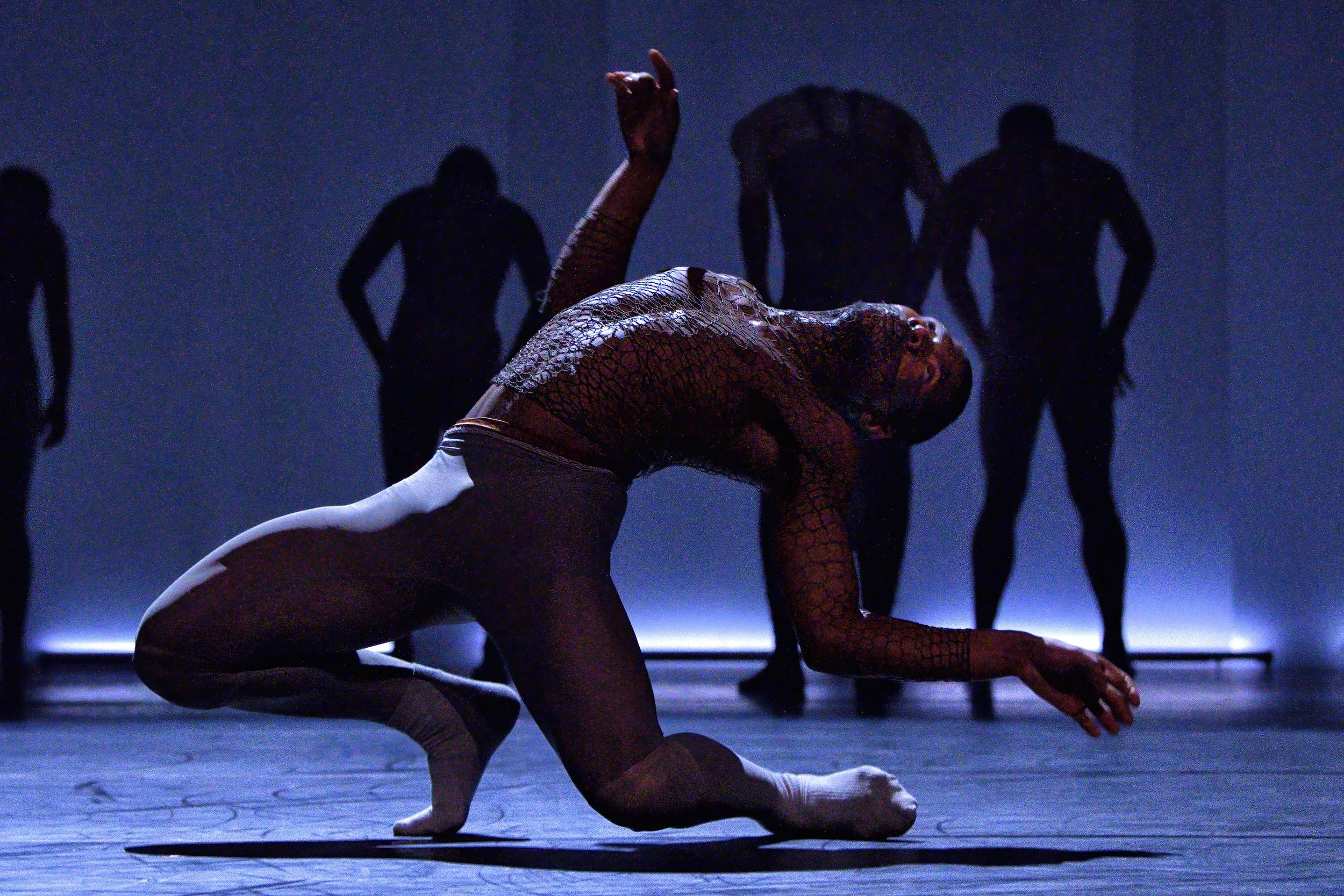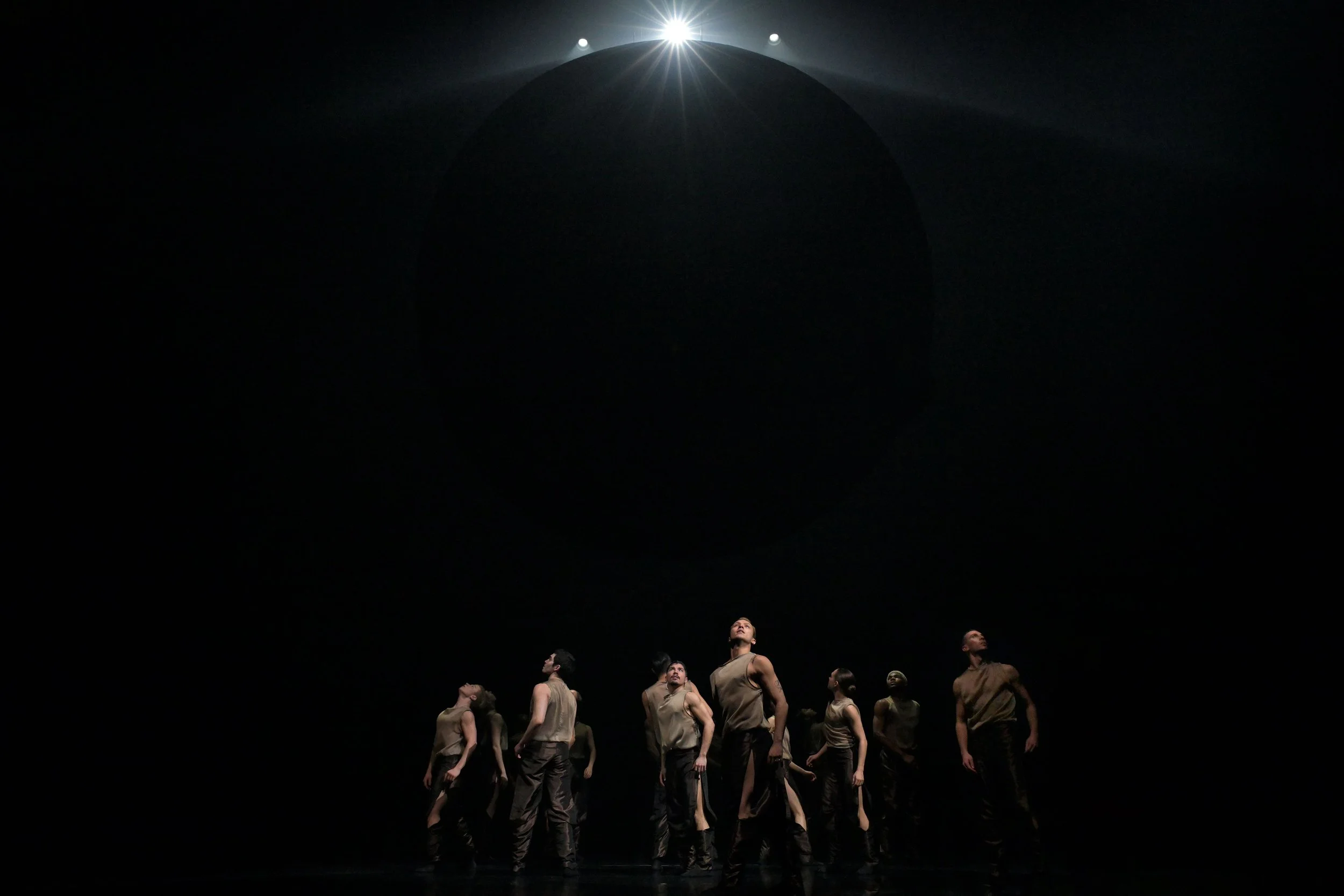Dance review: Sci-fi replicants and glowing rods, as striking imagery defines Ballet BC season-closer What If
An evening of all-new works from Dorotea Saykaly, Felix Landerer, and Vancouver’s own Out. Innerspace takes risks that pay off
Dancers Sarah Pippin and Justin Rapaport in the eerie, sci-fi-tinged RELIC. Photo by Michael Slobodian
Ballet BC presents What If at the Queen Elizabeth Theatre until May 14
THERE IS NO shortage of astonishing images in each of the new world premieres at Ballet BC’s season-closing program, What If.
In Dorotea Saykaly’s stunning RELIC, two bodies writhe inside a sheer-white nylon sack, before one emerges from the opening like a replicant birthed from a synthetic womb.
In Out Innerspace Dance Theatre’s Strange Attractor, dancers emerge eerily from darkness, black umbrellas opening and closing in front of them, puffing in and out like reptilian aliens.
And in Felix Landerer’s Everything will be okay, dancers duck and jump to avoid giant, fluorescent-lit poles that slice a circle across the floor–like hands of an otherworldly clock.
Those striking visuals give the evening a heightened feeling that goes beyond your normal night out at the ballet. Though their pieces have vastly different movement languages, each choreographer builds a distinct world onstage.
Saykaly’s eerie sci-fi exploration RELIC is nothing less than a thrilling revelation. Her first commission for Ballet BC is the result of the inaugural Emily Molnar Emerging Choreographer Award, and it carries the promise of a distinct new voice in dance. She shows the fearlessness and unearthly sensibility of Marie Chouinard or Sharon Eyal (both of whom she’s worked with) but has an almost filmic sensibility all her own.
Saykaly creates a lab-lit nightmare of droids revealed to us, one after another, in cylindrical spotlights. But it turns out these beautiful creatures can’t quite move like humans, glitching, rocking, and falling. Their arms won’t prop them up when they move on all fours, and their legs wrap in on themselves when they try to get off the floor. When they walk upright, it’s as if shoulders and ankles are askew; hips and spines swivel unnaturally. In a reverse “U”, one mutant arches backward, facing the audience upside-down, as she sidles across the stage. In other moments the bodies come together in sculptural groups, before moving away, broken again.
The dancers of Ballet BC are looking so strong these days, it’s hard to pick a favourite—and in RELIC, they fully commit to the mood of the piece, whether it’s Zenon Zubyk and Jacob Williams’s freakout pas de deux, Kiana Jung’s herky-jerky extensions across the stage, or Sidney Chuckas pulling off a boffo droid-ballet-break. Livona Ellis, Rai Srivastava, Miriam Gittens, Anna Bekirova—it’s impossible to give credit where it’s due in a work of this scale.
Dancer Sidney Chuckas strikes a synthetic-human pose in RELIC. Photo by Michael Slobodian
All the while, Saykaly’s clear, steady voice-over speaks like a scientist exploring what it means to create artificial life–and what it means to be human: “I wanted them to learn, remember, perceive”… “What’s the best version of yourself?”) That idea is heightened by Riku Mäkinen’s haunting score, an electro-industrial roar infused with strings, chorales, and other natural sounds.
A larger metaphor for change, advancement, and the human condition, RELIC is also just cool to watch—Bonnie Beecher’s cold space-age lighting, the subtly netted body suits by Kate Burrows—all building to a chilling finale.
A similar cinematic quality has always run through the work of David Raymond and Tiffany Tregarthen of Vancouver’s Out Innerspace Dance Theatre. Their first commission, Strange Attractor, continues in that vein. Set in motion by the sound of thunder, the first half creates a dreary world, with umbrellas puffing to life out of a dark void. From there, figures in long trench coats begin to swirl, crouching and coiled, lunging, and shaking their hands maniacally. In the most striking choreographic segments, they circle like rainwater gathering at a drainpipe.
Strange Attractor makes creative use of sinister black umbrellas. Photo by Michael Slobodian
The surprise you don’t expect to see from this duo comes in the second half. An earnest journey into pure, beautiful, flowing balletic dance, it finds the corps now dressed in lacy-flowery numbers, escaping the tension and darkness of the first section. The piano-set song about time disappearing is performed by Jermaine Spivey—who’s joined Tregarthen and Raymond onstage in celebrated Kidd Pivot productions like Revisor. The work could have stood starkly and strongly without the second half’s flowing catharsis—they felt like separate pieces, which was probably the point—but the audience, understandably, loved it.
The evening closer, German choreographer Landerer’s Everything will be okay, reads as a reaction to these tumultuous times. It’s a tribute to the resilience humanity has shown in an era of constantly avoiding obstacles—diving, weaving, and tumbling to outrun the clock. The huge glowing rods, operated by dancers turning at centre stage, start in slow motion and ever-so-gradually speed up. Rather than just building frenzy, the piece has a meditative sense of repetition to it; there’s a beautiful group section where hands reach out flat in unison, calmly smoothing the air, like a recentering ritual.
Dancer Anna Bekirova wields a giant glowing rod in Everything will be ok. Photo by Michael Slobodian
Landerer’s movement, though it’s highly physical, seems propelled less by technique and virtuosity than by authentic emotion. And the final moment, a moving gesture from one dancer to the audience, has the kind of fourth-wall-breaking, heartfelt authenticity that you don’t often get at an evening of contemporary dance.
In fact a lot of the What If program is not quite what you might expect from Ballet BC–especially if you think ballet is still about pointe shoes and arabesques, with or without tutus. Emerging boldly out of the pandemic, this is a company that’s taking risks right now, and judging from the audience’s reaction, that comes with big rewards.

















